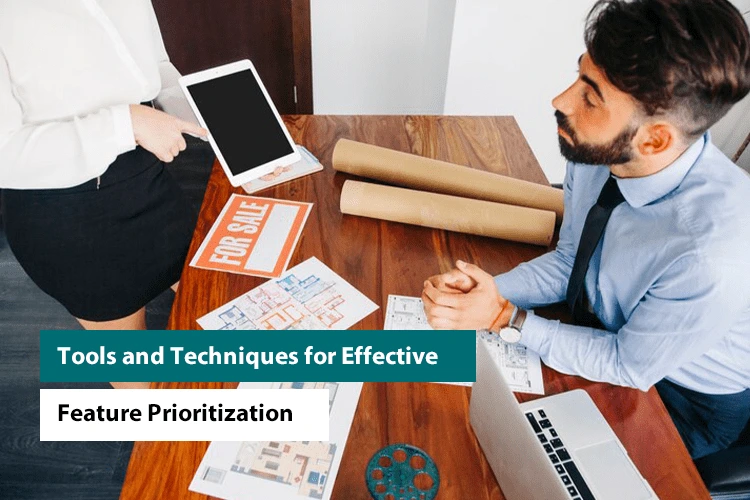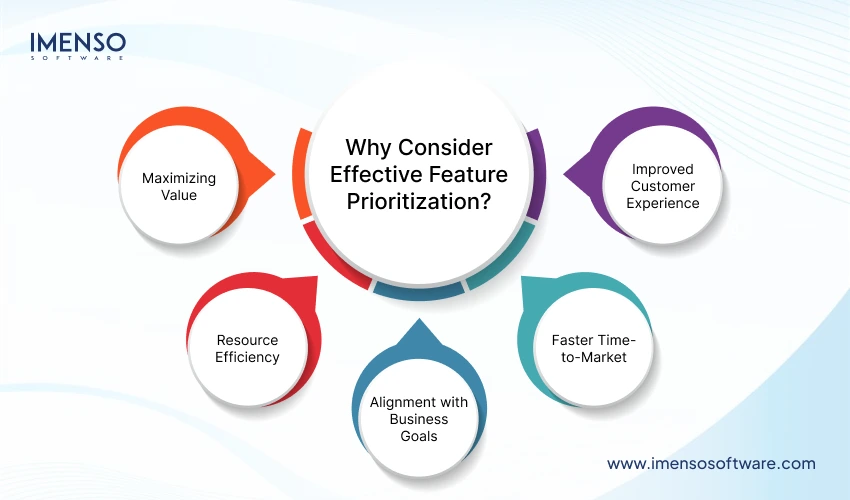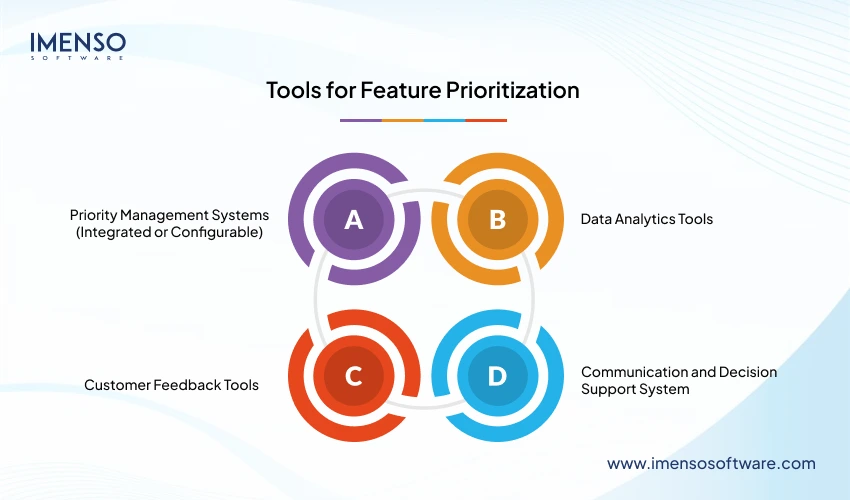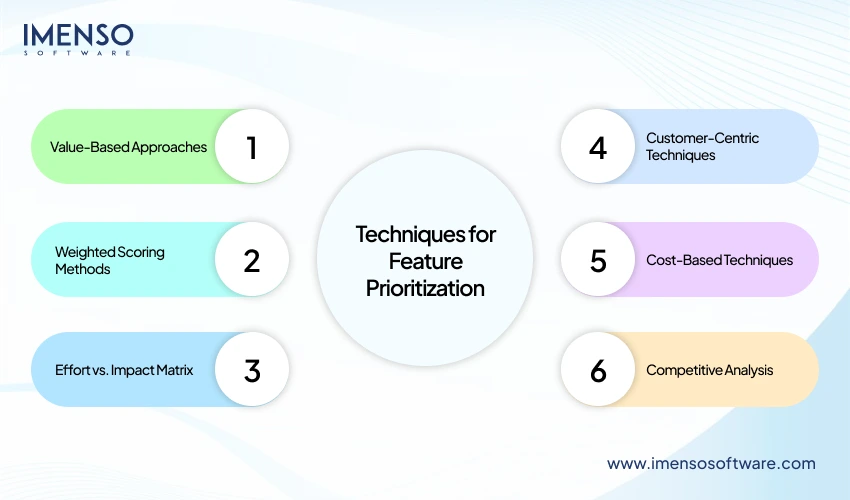Tools and Techniques for Effective Feature Prioritization

Feature prioritization refers to the process of selecting which features to implement in a product according to some sort of criteria, for instance, business relevancy, customer needs, technical possibility, and available resources. Feature prioritization enables the development team to work on features that will help an organization achieve its goals.
According to a research, it is estimated that about 70% of software projects do not achieve the set objectives mainly because they are not prioritized as they should be. As businesses deliver new products the decision of what to create next shapes the performance of the final product. Feature prioritization comes into play at this stage. It is an effective approach to identify the most valuable features, to deliver value effectively as well as as a strategy.
The concept of feature prioritization is not merely a process; it is central to the activities of a product manager. Due to the scarce time, materials, or customer willingness to wait, prioritization serves as a guiding star. It points development to the features that create value, engage users, and fit the business strategy. Startups such as Spotify and Amazon exist and remain competitive because they focus on elements people truly want. For example, curated music selections and convenient ordering.
Why Consider Effective Feature Prioritization?

Feature prioritization is important because it determines the overall effectiveness and enhancement of a product as per the business vision and the quality of services to customers. In leveraged product development scenarios, it becomes crucial for product teams to prioritize their efforts. This is because in these situations time, money, or people are scarce. They must ensure that every implemented feature adds as much value as possible. Here’s why prioritization matters:
Maximizing Value
Concentrate on elements that correspond to the customer’s needs or which are the most valuable in terms of revenues. It lets teams create products that are relevant to users and yield more results than similar offerings by competitors. This enables prioritization so that teams can understand which features yield the most return on investment (ROI). It thus helps with doing right things for the product.
Resource Efficiency
Development teams typically operate under restricted modes of finance, time, and number of employees. Failure to prioritize means that teams invest in something that is of little value to incorporate into their projects. This is not a problem if done correctly, that is why an effective prioritization allows the team to focus on high-impact features and optimize the work.
Alignment with Business Goals
All the features should align to achieve the goals of the organization. Placing importance on aspects that are relevant to the business strategies – new markets, customers, or profitability – makes the product improve according to the strategic goals.
Faster Time-to-Market
When teams are able to prioritize certain features, they are able to deliver products or updates faster, thus giving the users access to important features quickly. This not only increases users’ satisfaction but also competitiveness for the company within fast-growing markets.
Improved Customer Experience
There is always a need to prioritize depending on the needs of the customers and their perception of certain aspects. In this way, the relationships between features and customers’ needs are defined and products that meet both the users’ requirements and their perception of value can be developed, which will result in higher customer satisfaction and therefore, customer loyalty.
Feature prioritization enables a company to ensure that the development of a specific product is well-guided, targeted, and aligned. It optimizes the opportunity for success while at the same time reducing the likelihood of costs and losses.
Key Principles of Feature Prioritization
Several principles can help in making the right feature choices to guide feature development. These principles form a good basis for choosing tactics that optimize business value, meet customer requirements, and leverage the strengths of the team. Let’s break them down:
Strategic fit with Business Objectives and Strategy
The first approach to identifying which may be the most effective approach to prioritize features is the consideration of their alignment with the overall corporate strategy. All attributes should serve the long-term goals of the business by addressing the issues of revenue growth, the company’s market share, or customer retention.
Business Strategy Consistency: The priority-setting decisions must also conform to the company’s overreaching mission and goals/strategy. For example, if a company has a vision statement that points to it becoming the leading sustainable company, aspects that can decrease the effect that the firm’s products have on the environment should be looked at.
Cross-Functional Alignment: Some functional areas (like sales, marketing, and customer service) could possibly have dissimilar goals. Feature prioritization guarantees that all teams are on the same page in terms of ensuring that the product roadmap meets the needs of such stakeholders.
Maintaining a good relationship between the features and business objectives helps to control the kind of product being developed to fit into the customer’s demands as well as the company’s bottom-line objectives.
Customer-oriented Needs and Concerns
The customer is the centerpiece of feature prioritization. Understanding customer needs and the constant practice of collecting feedback guarantees that a feature developed is not only unique but also would make a substantial difference. The best of all these technical features do not work if they are not designed with the end user in mind.
Customer-Centric Approach: When addressing the question of prioritization, the concerns of users facing certain problems should always be considered. It can be conducted in the form of interviews, user feedback, group discussions, and customer support request analysis.
Voice of the Customer (VoC): Surveying tools such as the Net Promoter Score or the Customer Satisfaction Score enable organizations to know the overall attitude toward current features and which of the new features would be most preferred.
Customers should be the ultimate arbitrators, which means that their opinions should come before any assumptions or thoughts coming from inside the company. Expert opinions from the consumers are real and confirm the findings by the company, which makes the product adaptive and of better quality so that there is higher satisfaction and loyalty among the consumers.
Evaluation of the Specifications and Limitations of Technological Use
Although a feature can be strategic from customer and business perspectives, the technical feasibility of these features is a factor that determines priority. Regardless of creativity and enthusiasm, the development team must analyze whether the feature could be implemented given the technical and resourcing realities.
Resource Availability: When it comes to the feature, the level of its sophistication and how long it will take to cultivate are critical elements. Teams need to make decisions regarding whether they have the required skill and resources to construct the feature in one of the shortest ways possible.
Technical Debt: Essentials to be looked for including the current systems and the code already in place. Accounts that involve complex alterations, multiple test cycles, or improvements of technical debt must be carefully considered.
A practical technical evaluation guarantees that selected features can be achieved effectively and on schedule without trading off the product quality.
Substituting short-term wins with long-term planning
Prioritization of the features of certain software is all about the medium and long-term perspectives, but it also takes into contemplation the present requirements. While it is easy to devise certain features that will yield results, it is wrong to do so without contemplating their consequences in the future.
Quick Wins vs. Strategic Goals: There are short-term benefits including those useful in enhancing user experience or directly addressing customer concerns shortly. However, these should not blind the management from pursuing long-term strategic initiatives for the business.
Sustaining Growth: Evaluating the available opportunities by relying on the organization’s short-term goals may help in ensuring temporary gratification but denies the company vast development.
Finally, proper prioritization helps prioritize today’s needs and wants on one side and the vision of constant development and bringing out new features on the other.
Cost-benefit analysis and program evaluation
Return on Investment (ROI) is always one valid criterion when defining priorities. It compares the estimated consumer value of a feature against the costs of implementing such a feature.
Value vs. Cost: ROI takes into account the possible gain (such as extra sales, better customer satisfaction, market share, etc.) and the cost (concerning resources, time, and development, for instance) of providing a particular feature.
Quantitative Metrics: Organizations can then adopt relative measures such as Revenue Impact, Customer Retention, User Engagement, and Operational Efficiency to measure or gauge the likelihood of a feature
By calculating the return on each of the features and looking at the long-term effect, the teams can fine-tune the areas that are more valuable but also require minimal effort. From a business standpoint, prioritizing high-ROI features means keeping the product relevant, profitable, and as capable as possible of fulfilling the user’s wants and a business’s needs.
Tools for Feature Prioritization

Proper feature prioritization is heavily dependent on the selection of the right tools for feature prioritization, such as organization tools, analysis tools, and collaboration tools. Here are some key categories of tools used in the process:
Priority Management Systems (Integrated or Configurable)
Prioritization frameworks assist teams in coordinating the features into desirable performances by the prioritized measurements on the predefined criteria. Some of these tools for feature prioritization include Trello, Asana, and Jira with priority functions that include the use of boards, backslogs, and scorecards to prioritize features.
Even more tailored to the work of product teams there are Productboard and Aha! Apps that enable the scoring of features regarding business value, customer necessity, and development complexity. These frameworks can be implemented to be as unique as the way that the teams and products are different.
Data Analytics Tools
Business intelligence tools are useful for decision support since it is based on data analysis tools. Google Analytics and Mix Panel monitor the ways in which users interact with these features. It helps understand which aspects can be improved.
Hotjar has heatmaps and session recordings which makes it easy for the teams involved to explain how users interact with some aspects of the product. As a result of these tools for feature prioritization, teams can optimize features that solve user problems/blockers or explore features that are not being used well.
Customer Feedback Tools
From the perspective of SWOT analysis, the customer feedback used in prioritizing the features is highly important. Services like SurveyMonkey and Typeform allow the team concerned to elicit structured feedback from users about what features they appreciate the most.
Intercom and Zendesk help to find similar support tickets or customer questions about the same problem or feature. Further on the same point, there are sites such as Usabilityhub that enable different teams to share new features with prospective audiences before even creating them. They help to guarantee that the product decisions reflect real user needs.
Communication and Decision Support System
Communication tools are important for facilitating consensus and bringing clients, executives, and other stakeholders on the side of the product development team where priority decisions are concerned. Tools for feature prioritization like Miro or Mural let the team engage in voting on which features should be implemented next, and brainstorm solutions.
Slack and Microsoft Teams can enable rich discussions in the context of prioritization, where teams can obtain feedback and solve disputes in real time. These tools create multi-functional cooperation and help to avoid situations when some participants are out of step with others making key decisions.
Through the use of these tools for feature prioritization, it becomes easy for the groups to decide on the features to develop and implement since they meet customers’ needs, generate business value, and are implementable given the available technological supportive systems.
Techniques for Feature Prioritization

Below is a detailed list of techniques for feature prioritization:
Value-Based Approaches
Value-based approaches involve the assessment of the worth of each feature to the customer and the business. The most popular frameworks here are:
MoSCoW Method: According to the company needs, they are categorized as Must-haves, Should-haves, Could-haves, and Won’t-haves. This technique is of great assistance to implement important features first while placing less important ones second.
Kano Model: In this technique for feature prioritization, features are classified into Basic Needs Feature, Performance Needs Feature, and Excitement Features. It is aimed at customer centricity and guaranteeing minimum necessary values, while users get additional perks.
These approaches assist the team in prioritizing features that will in one way or the other assist the customers and the business in achieving their goals.
Weighted Scoring Methods
Weighted scoring techniques for feature prioritization involve assigning numerical values to different features in the option based on factors such as business importance, user need, and functional implementing ability. The most familiar method is RICE (Reach, Impact, Confidence, and Effort). Here the reach of each feature gets rated on these conditions. After that the developer multiplies it to obtain an estimate.
In most cases, features with the highest scores are preferred. It is an objective method that helps to bring data into the decision-making process which makes it more efficient.
Effort vs. Impact Matrix
A low-cost but highly efficient tool that you can solely rely on to determine the features based on how valuable they are to the customer or the business and how much effort it will take to implement them.
The priorities of features are determined according to the impact-effort matrix, with high impact and low effort features labeled as “Quick Wins” and with low impact and high effort features labeled as “Time Sinks. This makes it easier for the teams to make rapid decisions under certain conditions and prioritize high-value for low-cost activities.
Customer-Centric Techniques
Customer-centricity is important for achieving alignment with the market. Techniques include:
Customer Journey Mapping: This outlines the whole journey that a customer goes through. It assists in finding out areas where certain features will improve.
Jobs to Be Done (JTBD): JTBD comes from the job that is in front of the customers. It fits features with those jobs, it helps to understand what is important and to prioritize.
These techniques for feature prioritization maintain the end user as the focus of prioritization in order to always align with real customers’ issues.
Cost-Based Techniques
Here feature prioritization coming from on the ROI or the CoD identifies the features with the highest cost of delay. Features that skill potential for the highest return are given the most emphasis in ROI.
CoD quantifies the loss that results from postponing or excluding specific features. It makes it easy for teams to focus on features that would translate to more profit or decrease business expenses quickly. Such techniques are directed at achieving maximum profit and minimum time to market.
Competitive Analysis
There is the competitive analysis where one analyses the competitor’s product. They look at the areas in which he or she can set himself apart from competitors. In this manner, teams can focus on which features are unique. They can focus on more advanced features than what competitors are offering. This method is very useful in saturated markets because this is the key to surviving among competitors.
Experiments and Prototyping
Using prototyping ideas combined with running experiments enables the teams to introduce features. They can do so within a short span. At the same time, they receive responses from users before final consideration and prioritization. Techniques for feature prioritization like A/B testing, MVP, or running something through the feature toggle let the teams know whether a feature will be valuable to users or not. These methods minimize risks. This is because before going full scale into the development process the working hypothesis first needs testing.
With these techniques for feature prioritization, teams can manage challenges associated with feature prioritization and create products that meet user needs, organizational objectives, and market conditions.
Also Read:
A Guide to Hire Software Developers in India
Top 10 Programming Languages for 2025
How Custom Software Turns Boring Processes Into Revenue-Generating Engines
Conclusion: Take Control of Your Product Development with Imenso Software
In Imenso Software we recognize that feature prioritization is a key competency that defines successful software products. If done correctly and with the right approach, business organizations can make decisions based on the data. This enhances customer value. It helps to adequately position the product portfolio based on current business and customer needs. Whether dealing with the stakeholders’ requirements addressing technical constraints, the solution is in the systematic identification and management of priorities.
Imenso Software assists organizations in optimizing the feature prioritization approach to deliver value more effectively and quickly. We’re here to help you navigate the complexities of product development. We endeavour to build a product that not only meets specifications but also exceeds them.
Let us collaborate with you in changing your vision into a reality and developing the best solutions. Do not hesitate to contact Imenso Software today to begin implementing smarter processes for your product development and securing your continued success in a competitive environment.
Also, you can read our reviews on Clutch!
FAQs
What is feature prioritization all about?
Feature prioritization is ranking product features according to their impact and feasibility within business objectives about resource utilization.
What is feature prioritization, and why is it necessary?
This is useful to specific teams for the identification of high-impact features. It is also important for customer satisfaction, and the efficient way to allocate development resources towards business goals.
What are popular approaches to ranking the features?
Some popular approaches include Value-Based Approaches, Weighted Scoring, Effort vs. Impact Matrix, and Customer-Centric techniques.
Is it possible to apply competitive analysis for feature prioritization?
Yes, while evaluating competitors’ features, a person can come across some gaps in the current market. They can also pick some features that may suit it best.
Want more information about our services?
Similar Posts

Are You Looking To Hire React Native Developers To Build Mobile Apps?
When Facebook was looking for a technology to make the app more robust and fast without any downtime, that is when React Native was developed. And since its launch, it has been the talk of the app town. Facebook trusts its technology and so far has used React native to build Instagram and Facebook ads. ...

Enhance Your Business Website: Top 10 Must-Have WordPress Plugins
“Are you harnessing the full potential of your online presence to propel your business forward in today’s digital landscape?” In a world where over 40% of websites are powered by WordPress, it’s evident that businesses are turning to this versatile platform to establish their online presence. WordPress’s dominance isn’t just by chance; its robust ecosystem […]...

Developing Cross-Platform Mobile Apps with React Native and Its Advantages
In the rapidly evolving world of mobile app development, the need to deliver seamless user experiences across different platforms is paramount. Building separate native apps for iOS and Android can be time-consuming, costly, and resource-intensive. Enter React Native, a powerful framework that offers a solution to this problem. In this blog, we will explore the […]...









